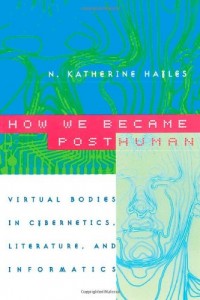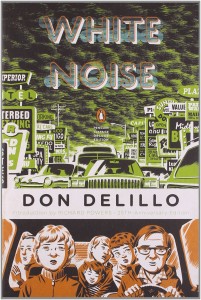Blog Post 3: Materialism Vs. Simulation: Don Delillo’s White Noise and Katherine Hayles’s How We Became Posthuman: Virtual Bodies in Cybernetics, Literature, and Informatics
In Chapter 2 of her critical text How We Became Posthuman: Virtual Bodies in Cybernetics, Literature, and Informatics (1999), titled “Virtual Bodies and Flickering Signifiers,” Katherine Hayles identifies the notion of the flickering (as opposed to the floating) signifier, the relationships between pattern and randomness in the digital era, and the potential for the amalgamation of the digital with the biological.

According to Hayles, the “flickering signifier” differs from the Lacanian “floating signifier” in that flickering signifiers belong uniquely to the technological age and tend toward “unexpected metamorphoses, attenuations, and dispersions…[signaling] an important shift in the plate tectonics of language” (30). In applying this notion of the flickering signifier to contemporary literature (predominantly postmodern American literature from the late 20th century), Hayles argues that a shift can be observed towards dematerialization and simulation, represented by the dichotomy of pattern/randomness, and away from the [material] construction of presence/absence. This shift, she contends, affects human (i.e. material) and textual (i.e. simulated) bodies on two simultaneous levels: on the one hand, “a change in the (material) body, and on the other a change in the message (the codes of representation)” (29).
I find Hayles’ discussion of the enmeshing of the biological with the technological especially convincing as it relates to Don Delillo’s White Noise (1985). With regard to the vexed relationship between simulation and materiality Hayles describes, Delillo’s Jack Gladney represents an interesting example: In simulating a field of studies (Hitler Studies) of which he declares himself the leading world expert and chair at The College on the Hill, Jack enables himself to earn a very real living and to participate in the material culture of late capitalism on which the narrative centers.

However, this relationship of the real to the simulated is perhaps best exemplified in the middle section of the novel titled, “The Airborne Toxic Event,” which Hayles gives brief reference to in her chapter, but that I would like to examine more closely here. In this particular scene, the Gladneys are forced to evacuate their hometown due to a chemical spill and the potentially harmful cloud of black smoke it produces. The evacuation is led by the organization SIMUVAC (short for “simulated evacuation,” pointedly), and requires each citizen to undergo an examination to check for contaminants. An excerpt of Jack’s exchange with a SIMUVAC worker, here:
Jack: “But you said we have a situation.”
SIMUVAC worker: “I didn’t say it. The computer did. The whole system says it. It’s what we call a massive data-base tally. Gladney, J.A.K. I punch in the name, the substance, the exposure time and then I tap in your computer history. Your genetics, your personals, your medicals, your psychologicals, your police-and-hospitals. It comes back pulsing stars. This doesn’t mean anything is going to happen to you as such, at least not today or tomorrow. It just means you are the sum total of your data. No man escapes that.”
“And this massive so-called tally is not a simulation despite that armband you’re wearing. It is real.”
“It is real,” he said.
As the excerpt shows, Jack’s biological “sum total” is reduced to computer-generated data. As Hayles notes, a defining feature of the posthuman is this deep entangling of the human with machine: “The posthuman implies not only a coupling with intelligent machines,” she writes, “but a coupling so intense and multifaceted that it is no longer possible to distinguish meaningfully between the biological organism and the informational circuits in which the organism is enmeshed” (35). Put simply, Hayles identifies not only a reliance of the [post]human on digital/cyber machines for gathering and producing data, but as a way of defining itself either alongside or against this data. Jack’s diagnosis of “pulsing stars” thus proves problematic; a combination of his material history (his “genetics, personals, medicals, psychologicals” and so forth) produces unreadable data to the human. The “pulsing stars” that comprise J.A.K. Gladney are readable and logical only to the technological realm of the computer, or the “codes of representation” as Hayles puts it. As a result, Jack’s mortality is summed by “informational patterns” that predict his eventual death (40).
Sources:
Delillo, Don. White Noise. Penguin Classics: New York, 2009. Print.
Hayles, Katherine. How We Became Posthuman: Virtual Bodies in Cybernetics, Literature, and Informatics. University of Chicago Press: Chicago, 1999. Web. 5 Feb 2016.